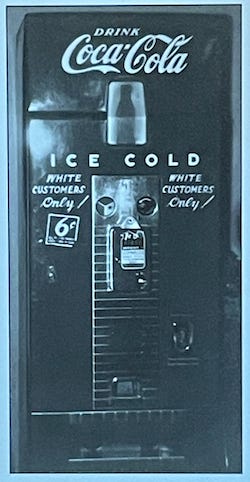Hi all,
Thank you for joining me for this week’s song, Too Many Martyrs (Ballad of Medgar Evers), by Phil Ochs. I will also include the video of The Freedom Singers singing They Laid Medgar Evers in His Grave, a beautiful hymn to the memory of Medgar Evers.
If you’d like to hear the song before you read the background, I’ve included a YouTube video below the article.
Below, you’ll find some background information and my interpretation of the lyrics, written in italics. Questions or comments are most welcome!
For Japanese students, vocabulary words in bold are provided in Japanese below.
The Song
(648 words)
Medgar Evers was born and raised in Decatur, Mississippi, in 1925. To go to school every day, he and his siblings had to walk 19 kilometers to the school that was only for black children. When he was young, a friend of his family was lynched. The community left the man’s bloody clothing on a fence in order to intimidate the black people living in Decatur. (1)
In the state of Mississippi many years ago
A boy of 14 years got a taste of Southern law
He saw his friend a-hanging and his color was his crime
And the blood upon his jacket left a brand upon his mind
Evers grew up in the segregated south. In most of the south and other parts of the U.S. at the time, there were strict rules about how African Americans could act, the places they could go, and the community services they had access to (parks, cinemas, drinking fountains, and even vending machines).
When he grew up, Evers joined the Army, and he fought in WWII. He found that when he was in Europe, he was treated as equal to white people, but back in the U.S., things had not changed. He went to Alcorn College and earned a business degree. He married a classmate, Merle Beasley, and they had three children.
Evers then started working in the insurance industry. He saw firsthand the poverty in which black people were living. He decided to take action, and joined the National Association for the Advancement of Colored People (NAACP). He organized protests, voter registration drives, and boycotts to try to end the segregation that was part of society at the time. He also tried to enter to law school at the University of Mississippi, but he was not accepted because he was black.
When Emmett Till was murdered, Medgar Evers helped to find black witnesses who might be willing to testify at the trial of his killers. After the trial, when Milam and Bryant were found innocent, Evers and other NAACP leaders helped the black witnesses escape to safer locations.
His name was Medgar Evers and he walked his road alone
Like Emmett Till and thousands more whose names we’ll never know
Medgar Evers became the target of white supremacists. In early 1963, they tried to burn his home by throwing a firebomb at his house. On the evening of June 12, 1963, Evers was returning home from a meeting with the NAACP. A white man named Byron de la Beckwith was waiting in the dark and, as Evers stepped out of his car, shot Evers in the back. Medgar’s wife found Evers and rushed him to the hospital. At first, the hospital would not let him in because he was black, but when they realized who he was, they admitted him. He died a short time after.
The killer waited by his home hidden by the night
As Evers stepped out from his car into the rifle sight
He slowly squeezed the trigger, the bullet left his side
It struck the heart of every man when Evers fell and died
Too many martyrs and too many dead. In this song, Phil Ochs remembers not only Medgar Evers but also the many, many black people around the country who gave their lives to stop the segregation, discrimination, abuse, and injustice they experienced. He criticizes the promises of people in government leadership who claim that “something must be done” but then do not enforce the laws of the country.
Too many lies too many empty words were said
Too many times for too many angry men
On the night he died, Medgar Evers was carrying T-shirts that said, “Jim Crow must go.” Jim Crow was the set of unspoken laws that kept blacks from being recognized as full citizens. Phil Ochs makes the same plea:
Oh, let it never be again.
VOCABULARY
sibling 兄弟
intimidate 威嚇する
segregate 住み分ける
vending machines 自動販売機
firsthand 直に
voter registration drive 有権者登録運動
murder 殺人
witness 証人
testify 証言する
trial 裁判
innocent 無実
white supremacists 白人至上主義者
martyr 殉教者
discrimination 差別
abuse 虐待
injustice 不公正
enforce 施行
plea 嘆願
Extra
Below the video of Phil Ochs, I include The Freedom Singers singing They Laid Medgar Evers in His Grave. In the fourth verse, they sing:
Medgar had some company in his heavenly home
Those little children from Birmingham
Like Christ they died for you and for me
They died for you to be free
The “little children from Birmingham” refers to four little black girls who died in the bombing of the 16th Street Baptist Church in Birmingham, Alabama, on September 15, 1963.
SOURCES
(1) Life of Medgar Evers. Medgar Evers College. (2021, July 6). https://www.mec.cuny.edu/history/life-of-medgar-evers/. Accessed June 17, 2023.
Public Broadcasting Service. The impact of Emmett Till’s murder. PBS. https://www.pbs.org/wgbh/americanexperience/features/emmett-impact-emmett-tills-murder/. Accessed June 17, 2023.
Wikimedia Foundation. (2023, June 13). Medgar Evers. Wikipedia. https://en.wikipedia.org/wiki/Medgar_Evers. Accessed June 17, 2023.
Photos: The Civil Rights Movement. Library of Congress Knowledge Cards (TM)







Thank you, Louise, for bringing this part of my life history back to me. There’s a lot I’ve forgotten or never knew under the headlines. A fine, brave man he was.
Thanks, Louise. Will check out these links.